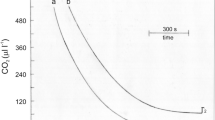Abstract
Photosynthesis of Ectocarpus siliculosus (Dillwyn) Lyngb. under continuous saturating red irradiation follows a circadian rhythm. Blue-light pulses rapidly stimulate photosynthesis with high effectiveness in the troughs of this rhythm but the effectiveness of such pulses is much lower at its peaks. In an attempt to understand how blue light and the rhythm affected photosynthesis, the effects of inorganic carbon on photosynthetic light saturation curves were studied under different irradiation conditions. The circadian rhythm of photosynthesis was apparent only at irradiances which were not limiting for photosynthesis. The same was found for blue-light-stimulated photosynthesis, although stimulation was observed also under very low red-light irradiances after a period of adaptation, provided that the inorganic-carbon concentration was not in excess. Double-reciprocal plots of light-saturated photosynthetic rates versus the concentration of total inorganic carbon (up to 10 mM total inorganic carbon) were linear and had a common constant for half-saturation (3.6 mM at pH 8) at both the troughs and the peaks of the rhythm and before and after blue-light pulses. Only at very low carbon concentrations was a clear deviation found from these lines for photosynthesis at the rhythm maxima (red and blue light), which indicated that the strong carbon limitation specifically affected photosynthesis at the peak phases of the rhythm. Very high inorganic carbon concentrations (20 mM) in the medium diminished the responses to blue light, although they did not fully abolish them. The kinetics of the stimulation indicate that the rate of photosynthesis is affected by two blue-light-dependent components with different time courses of induction and decay. The faster component seemed to be at least partially suppressed at red-light irradiances which were not saturating for photosynthesis. Lowering the pH of the medium had the same effects as an increase of the carbon concentration to levels of approx. 10 mM. This indicates that Ectocarpus takes up free CO2 only and not bicarbonate, although additional physiological mechanisms may enhance the availability of CO2.
Similar content being viewed by others
Abbreviations
- TIC:
-
total inorganic carbon
References
Axelsson, I., Uusitalo, J. (1988) Carbon acquisition strategies for marine macroalgae. I. Utilization of proton exchanges visualized during photosynthesis in a closed system. Marine Biol. 97, 295–300
Badour, S.S., Irvine, B.R. (1990) Activities of photosystems I and II in Chlamydomonas segnis adapted and adapting to air and air-enriched with carbon dioxide. Bot. Acta 103, 149–154
Blackman, F.F. (1905) Optima and limiting factors. Ann. Bot. 19, 281–295
Bürger, J., Miyachi, S., Galland, P., Senger, H. (1988) Quantum requirements of photosynthetic oxygen evolution and 77 k fluorescence emission spectra in unicellular green algae grown under low- and high-CO2 conditions. Bot. Acta 101, 229–232
Forster, R., Dring, MJ. (1991) Interactions of blue light and inorganic carbon supply in the control of light-saturated photosynthesis in brown algae. Plant Cell Environ., in press
Gergis, M.S. (1972) Influence of carbon dioxide supply on the chloroplast structure of Chlorella pyrenoidosa. Arch. Microbiol. 83, 321–327
Marcus, Y., Schuster, G., Michaels, A., Kaplan, A. (1986) Adaptation to CO2 level and changes in the phosphorylation of thylakoid proteins during the cell cycle of Chlamydomonas reinhardtii. Plant Physiol. 80, 604–607
Müller, D. (1962) Über Jahres- und lunarperiodische Erscheinungen bei einigen Braunalgen. Bot. Mar. 4, 140–155
Raven, J.A., Johnston, A.M. (1990) Effects of culture in high CO2 on the photosynthetic physiology of Fucus serratus. Br. Phycol. J. 25, 75–82
Raven, J.A. (1970) Exogenous inorganic carbon sources in plant photosynthesis. Biol. Rev. 45, 167–221
Raven, J.A., Osborne, B.A., Johnston, A.M. (1985) Uptake of CO2 by aquatic vegetation. Plant Cell Environ. 8, 417–425
Schmid, R., Dring, M. (1991) Circadian rhythm and fast responses to blue light of photosynthesis in Ectocarpus (Phaeophyta, Ectocarpales). I. Characterization of the rhythm and the blue-light response. Planta 187, 53–59
Spalding, M.H., Critchley, C., Govindjee, Ogren W.L. (1984) Influence of carbon dioxide concentration during growth on fluorescence induction characteristics of the green alga Chlamydomonas reinhardtii. Photosynth. Res. 5, 169–176
Surif, M.B., Raven, J.A. (1989) Exogenous inorganic carbon sources for photosynthesis in seawater by members of the Fucales and the Laminariales (Phaeophyta): ecological and taxonomical implications. Oecologia 78, 97–105
Tan, C.K., Badour, S.S. (1983) Photoassimilation of inorganic carbon in Chlamydomonas segnis during cell development at low and high carbon dioxide tension. Z. Pflanzenphysiol. 109, 113–125
Tsuzuki, M., Miyachi, S. (1989) The function of carbonic anhydrase in aquatic photosynthesis. Aquat. Bot. 34, 85–104
Author information
Authors and Affiliations
Rights and permissions
About this article
Cite this article
Schmid, R., Forster, R. & Dring, M.J. Circadian rhythm and fast responses to blue light of photosynthesis in Ectocarpus (Phaeophyta, Ectocarpales). Planta 187, 60–66 (1992). https://doi.org/10.1007/BF00201624
Accepted:
Issue Date:
DOI: https://doi.org/10.1007/BF00201624




